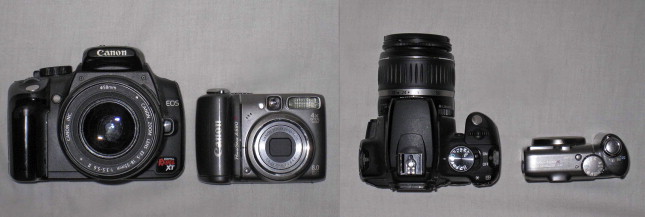Clinical photography is a critical component of the practice of facial plastic surgery. Potential for a wide variety of applications for these photographs, such as medicolegal documentation, patient counseling, teaching of colleagues and physicians in training, and lecture presentations. Photographs are important to facilitate understanding of surgical techniques described in the literature. Clinical photographs are also used for advertising in many practices. Good-quality photographs are therefore important. There are several factors that contribute to quality, such as the appropriate setting and background, standardization of subject position, and the type of flash. However, none of these factors can be effective without a good camera and lens. A multitude of cameras and lenses are available, and choosing the correct equipment for your practice can be confusing. In many practices, the surgeon also functions as his or her own photographer. At a minimum, it is important to have a basic knowledge of camera and lens equipment.
Clinical photography is a critical component of the practice of facial plastic surgery. Potential for a wide variety of applications for these photographs, such as medicolegal documentation, patient counseling, teaching of colleagues and physicians in training, and lecture presentations. Photographs are important to facilitate understanding of surgical techniques described in the literature. Clinical photographs are also used for advertising in many practices. Good-quality photographs are therefore important. Several factors contribute to quality, such as the appropriate setting and background, standardization of subject position, and the type of flash; however, none of these factors can be effective without a good camera and lens. A multitude of cameras and lenses are available, and choosing the correct equipment for your practice can be confusing. In many practices, the surgeon also functions as his or her own photographer. At a minimum, it is important to have a basic knowledge of camera and lens equipment.
Format
The 35-mm film has long been the gold standard of medical photography. Indeed, the quality of standard 35-mm film images is yet to be surpassed. However, purchasing, developing, and storing film for a 35-mm system has become increasingly expensive, and availability has diminished over the last few years. Recently, Kodak announced that after having manufactured Kodachrome film for 74 years, it would stop by the end of 2009. Just finding a new 35-mm camera to purchase in today’s market is difficult, unless one is willing to purchase used equipment.
Given the convenience and broad capabilities of modern digital cameras, more and more physicians are switching to digital systems. The digital format offers clear cost advantages by reducing the need to purchase film as well as by reducing developing, printing, and storage expenses. Another clear advantage of digital photography over film is immediate confirmation that the desired image has been captured on the liquid crystal display (LCD) screen. This quick feedback allows inferior-quality images to be retaken and undesired images to be immediately discarded. Similar to conventional 35-mm film cameras, digital cameras are available in point-and-shoot (compact) and digital single-lens reflex (DSLR) models ( Fig. 1 ). Digital camera selection should be governed by need, cost considerations, and a balance between the amount of training required for operation of the new camera and the willingness to devote the necessary time to become proficient.

Overview of digital camera types
Digital point-and-shoot cameras are small, inexpensive, and easy to use. Most models have an LCD screen instead of an optical viewfinder that the photographer looks through while holding up the camera to the face. The photographer must hold the camera away from his or her body to view the LCD screen, leading to instability that increases shake resulting in blurry images. Models with an optical viewfinder tend to crop the image inaccurately, because the viewfinder is simply a window through the body of the camera. The image seen through the viewfinder is slightly offset from the view through the lens; therefore, it only approximates the final image. Exposure and focus are usually set automatically on point-and-shoot models, allowing the photographer to obtain good-quality images quickly and with little training. This ease of use, however, sometimes comes at the expense of inaccurate white balancing or motion blur. The DSLR camera overcomes the disadvantages of the point-and-shoot models but at a cost ( Fig. 2 ).

The term DSLR generally refers to cameras that resemble 35-mm format cameras. The basic operation of a DSLR is as follows: for viewing purposes, the mirror reflects the light coming through the attached lens upwards at a 90° angle. The light of the image is then reflected twice by a series of mirrors, rectifying it for the photographer’s eye. During exposure, the mirror assembly swings upward, the aperture narrows (if stopped down or set smaller than wide open), and a shutter opens, allowing the lens to project light onto the image sensor. A second shutter then covers the sensor, ending the exposure, and the mirror lowers while the shutter resets. The period during which the mirror is flipped up is referred to as “viewfinder blackout.” A fast-acting mirror and shutter are preferred so as to not delay an action photo. All of this happens automatically over a period of milliseconds, with cameras designed to do this 3 to 10 times a second.
DSLRs are often preferred by professional still photographers because they allow an accurate preview of framing close to the moment of exposure. DSLRs also allow the user to choose from a variety of interchangeable lenses. Most DSLRs also have a function that allows accurate preview of depth of field. Many professionals also prefer DSLRs to most compact digitals for their larger sensors. These sensors are generally closer in size to the traditional film formats that many current professionals started out using, and allow for depths of field and picture angles that are similar to film formats.
Most DSLR models come with removable lenses and external flashes and enable the operator to choose between automatic exposure and focus settings and manual settings. DSLRs are more expensive than point-and-shoot models. The addition of options increases the price, while the learning curve becomes increasingly steeper. Nevertheless, with increased demand and advances in technology, DSLR cameras are becoming smaller, lighter, cheaper, and less complicated to use.
Overview of digital camera types
Digital point-and-shoot cameras are small, inexpensive, and easy to use. Most models have an LCD screen instead of an optical viewfinder that the photographer looks through while holding up the camera to the face. The photographer must hold the camera away from his or her body to view the LCD screen, leading to instability that increases shake resulting in blurry images. Models with an optical viewfinder tend to crop the image inaccurately, because the viewfinder is simply a window through the body of the camera. The image seen through the viewfinder is slightly offset from the view through the lens; therefore, it only approximates the final image. Exposure and focus are usually set automatically on point-and-shoot models, allowing the photographer to obtain good-quality images quickly and with little training. This ease of use, however, sometimes comes at the expense of inaccurate white balancing or motion blur. The DSLR camera overcomes the disadvantages of the point-and-shoot models but at a cost ( Fig. 2 ).
The term DSLR generally refers to cameras that resemble 35-mm format cameras. The basic operation of a DSLR is as follows: for viewing purposes, the mirror reflects the light coming through the attached lens upwards at a 90° angle. The light of the image is then reflected twice by a series of mirrors, rectifying it for the photographer’s eye. During exposure, the mirror assembly swings upward, the aperture narrows (if stopped down or set smaller than wide open), and a shutter opens, allowing the lens to project light onto the image sensor. A second shutter then covers the sensor, ending the exposure, and the mirror lowers while the shutter resets. The period during which the mirror is flipped up is referred to as “viewfinder blackout.” A fast-acting mirror and shutter are preferred so as to not delay an action photo. All of this happens automatically over a period of milliseconds, with cameras designed to do this 3 to 10 times a second.
DSLRs are often preferred by professional still photographers because they allow an accurate preview of framing close to the moment of exposure. DSLRs also allow the user to choose from a variety of interchangeable lenses. Most DSLRs also have a function that allows accurate preview of depth of field. Many professionals also prefer DSLRs to most compact digitals for their larger sensors. These sensors are generally closer in size to the traditional film formats that many current professionals started out using, and allow for depths of field and picture angles that are similar to film formats.
Most DSLR models come with removable lenses and external flashes and enable the operator to choose between automatic exposure and focus settings and manual settings. DSLRs are more expensive than point-and-shoot models. The addition of options increases the price, while the learning curve becomes increasingly steeper. Nevertheless, with increased demand and advances in technology, DSLR cameras are becoming smaller, lighter, cheaper, and less complicated to use.
Stay updated, free articles. Join our Telegram channel

Full access? Get Clinical Tree







